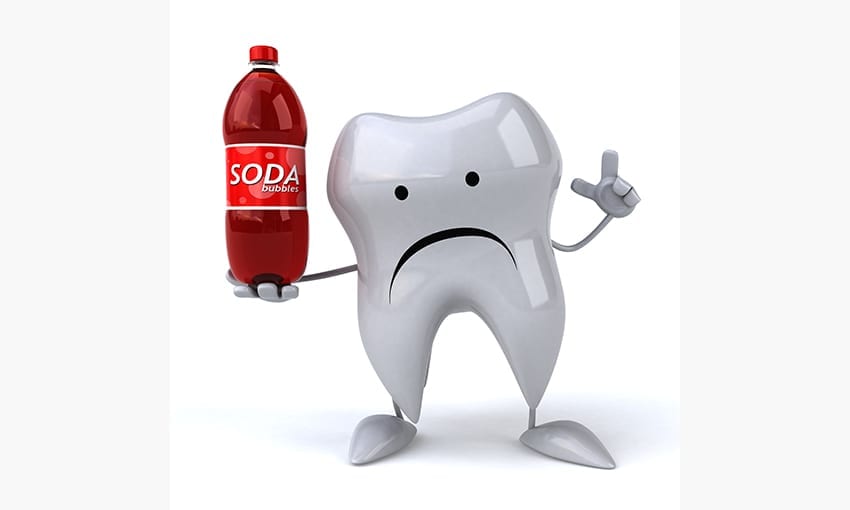When people think about things that may damage or breakdown their teeth, they often think of things like sugars and sweets.
Many people are unaware of the damaging effects that acids can have on the enamel of our teeth.
What is enamel erosion?
Enamel erosion can be described as a breakdown of the enamel surface by acidic substance exposure that does not involve plaque.
Enamel erosion is becoming increasingly prevalent in recent years, possibly due to the popularity of sports drinks and fruit juices.
What causes enamel erosion?
There are many causes of enamel erosion including:
- Consumption of acidic beverages such as carbonated soft drinks including diet soft drinks (Many diet soft drinks have a higher acid content to make up for the lack of sugars).
- Consumption of non- carbonated: fruit juices, sports drinks and alcohol.
- Gastrointestinal upset (GORD, Reflux).
- Bulimia.
- Chronic vomiting conditions.
- Dietary habits such as frequent consumption of lemons or other citrus fruits.
- Salivary dysfunction – ‘Xerostomia’ otherwise known as ‘dry mouth syndrome’.
- Recreational drug use.
- Chewing of vitamin C tablets beyond the recommended daily dose.
What are the symptoms of enamel erosion?
- Smooth, shiny enamel which appears in correlation with the type of acid involved. For example in patients with GORD (Reflux), uniform enamel wear is often evident on the inside surfaces of the teeth and in particular the lower molars.
- Affected tooth surfaces may appear darker or grey in shade as the underlying dentine is more exposed.
- The detrimental effects of erosion are often escalated by abrasion (usually by tooth brushing). You will see an increase in fine lines in the enamel caused by the bristles of your toothbrush and this may be evident on dental examination.
- An increase in tooth wear – teeth may appear shorter. The enamel may wear away at an increased speed in the event of tooth grinding (Bruxism). It is common to see evidence of tooth grinding and erosion particularly in the lower incisor area.
- An increase in tooth decay (Dental Caries).
- An increase in sensitivity – as the protective enamel is gradually reduced.
How can enamel erosion be prevented?
- Be aware of the causes.
- Dietary control – reducing the frequency in which acidic food is consumed and increasing water intake (including drinking a glass of water after consuming acidic food or beverages) is advised.
- Limit consumption of sports drinks or other acidic soft drinks when you are dehydrated and your mouth is dry, such as after playing sport.
- Saliva is recognised as an important biological factor in minimising enamel wear in erosive/abrasive attacks. It is thought that the calcium, phosphate and fluoride present in saliva can assume the repairing effect of initial enamel lesions – so stay hydrated!
- Chewing sugar free gum such as ‘Extra’ will improve saliva output and help to counteract erosive attacks. Sugar free gums containing CPP- ACP (casein phosphopeptide-amorphous calcium phosphate) such as ‘Recaldent’ (available from VC Dental) have been shown to increase enamel hardening from acid attacks.
- Brushing immediately after an acid intake (such as a soft drink or immediately after vomiting) can have detrimental and non- reversible effects on the now softened tooth enamel. It is therefore important to wait a minimum one hour in addition to rinsing with tap water prior to any form of brushing.
- CPP – ACP (casein phosphopeptide-amorphous calcium phosphate) products such as Tooth Mousse incorporated in a regular home oral health regime may be beneficial for those at high risk of developing enamel erosion. The CPP-ACP combination is absorbed on the tooth surface, increasing the level of calcium phosphate in the dental biofilm and releasing calcium and phosphate ions to the tooth when in an acidic environment. This helps by preventing demineralisation and providing immediate remineralisation of the enamel surface. (Yamaguchi et al 2006).
- Regular dental visits to identify enamel erosion.
Treatment for enamel erosion:
The usage of products to help re-mineralise the tooth enamel, such as toothpastes containing a high fluoride content (e.g. Colgate Neutrafluor 5000) have been shown to increase the hardness of the tooth enamel.
Fluoride varnish applications by dental professionals (in office) has been shown to be effective in reducing erosive wear.
In severe cases of enamel erosion, restorative dentistry can improve the longevity of affected teeth. The affected tooth may be restored by composite filling materials or stronger restorative materials such as porcelain. Restoration of affected dentition will ensure functional dentition for life. It is important to consider the effects of bruxism (tooth grinding) when considering restoration work and a night splint (Occlusal Splint) may be made to alleviate the heavy load on affected teeth.
References:
Case reports in dentistry Volume 2014: Case Report Dental Erosion from an Excess of Vitamin C, Bahal P, Djemal S (2014 Article ID 485387, 5 pages).
Journal of Dentistry: Effect of CPP-ACP paste on mechanical properties of bovine enamel as determined by an ultrasonic device, Yamaguchi K, Miyazaki M, Takamizawa T, Inage H, Moore BK (2006; 34(3):230-6).


